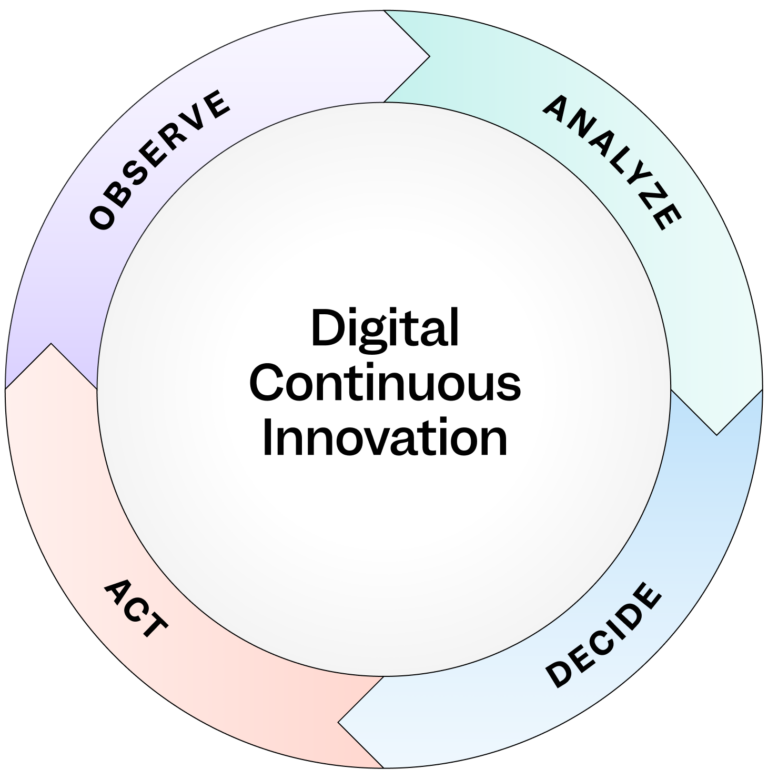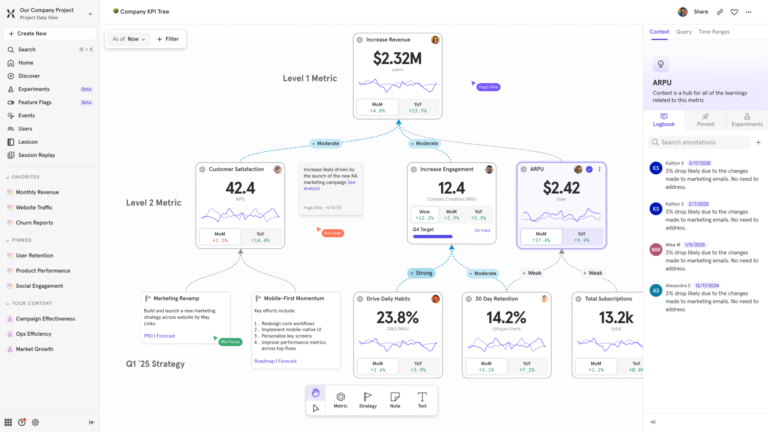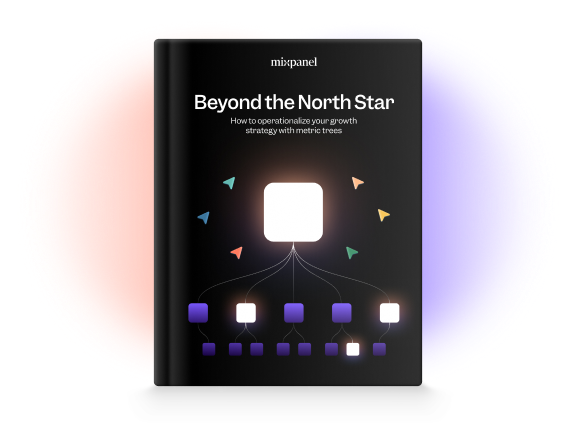
Powering growth: A conversation on digital continuous innovation with Mixpanel CPO, Edward Hsu

Today, we're sitting down with Edward Hsu, Chief Product Officer at Mixpanel, to discuss a critical driver of modern business success: digital continuous innovation (DCI). Ed will shed light on how enterprises can leverage DCI to accelerate from data insight to measurable impact.
How would you define digital continuous innovation (DCI) for enterprise leaders?
Digital continuous innovation is a disciplined, ongoing cycle of discovery, alignment, and improvement. It’s a way companies work to help ensure their innovation engine is humming but also empowering cross-functional teams, particularly in product and marketing, to leverage real-time data to continuously optimize digital experiences. The core idea is to link data-informed product decisions directly to measurable outcomes through rapid, iterative cycles, forming a unique insight-impact loop.
How is DCI unique from data science and BI and why do enterprises need all three?
That's a great question, as they all involve data but serve distinct purposes.
BI primarily answers "how are we doing?" using dashboards and reports to ensure teams understand current product or service performance. Data science is about generating insights to guide strategic decisions and improve operational efficiency, often involving open-ended research over months to find new product lines or strategic pivots.
DCI is distinct in its focus and cadence. It's about discovering and acting on opportunities to enhance new and existing solutions, enabling rapid, insight-to-action loops that operate in days or weeks, not months. BI and data science are critical; but DCI empowers the most individuals in the shortest timeframe to optimize digital products and customer experiences. Enterprises need all three because they represent different data-to-value chains that involve different people, processes, and tools, each playing important, distinct roles at a unique pace. This allows organizations to operate effectively at strategic, operational, and tactical levels simultaneously.

What are the most common challenges enterprises face when implementing DCI?
We often see three common challenges: misalignment, entanglement, and bottlenecks. With misalignment, data isn't properly shared between teams, and metric definitions can differ across tools, leading to situations where teams can't agree on basic facts, like what constitutes an "active user." Solutions include establishing a common semantic layer or cross-team working groups to agree on key metrics.
Entanglement occurs when complex interdependencies mean one value stream can't function without disrupting another. A common example is DCI being blocked because product managers can't get answers to basic product metric questions, overwhelming data scientists. Tackling this requires self-service product analytics to empower users to confidently perform their investigations.
Even if value streams are self-sufficient, disconnected tools or broken handoffs (i.e., bottlenecks) can slow progress. For instance, a product manager might identify a problematic user cohort but struggle to find relevant session replays for diagnosis, or can't run experiments without engineering involvement. Removing these bottlenecks means addressing tools and handoff gaps that block DCI, often by choosing tools that support end-to-end workflows or integrate well.
At the end of the day, these challenges reduce speed-to-impact, delay decisions, and limit an organization's ability to continuously improve the user experience in real-time.
Why is mastering DCI crucial for enterprise growth and what competitive advantage does it confer?
Mastering DCI is crucial because it directly empowers the most individuals in the shortest timeframe, making it a priority for fast-moving growth, product, and marketing teams globally. Companies that invest properly in DCI gain a significant advantage. They can iterate quicker, personalize experiences based on real-time engagement, and adapt to market signals far more rapidly than their competitors. This leads to faster product-market fit cycles, better user engagement and retention, and ultimately, sustainable business growth. It's about building the right things in the first place, ensuring that execution is purposeful and delivers customer value.
How does the OADA loop drive results in digital product development?
The OADA loop is the fundamental operating model for DCI, operationalizing continuous innovation. It's a cyclical process designed to empower teams to drive innovation transparently, quickly, and repeatedly.
During the observe stage, teams gather data from systems, users, and processes. This includes both quantitative metrics like usage and conversion, and qualitative signals such as feedback and session replays to understand what's happening. Next is analyze, where teams interpret this data to uncover patterns, issues, or opportunities. This could involve segmentation, funnel analysis, retention studies, or root cause investigations.
Third is decide where, based on the analysis, teams prioritize actions, balancing business impact, feasibility, and urgency to determine what improvements to make. Finally, the action stage is where teams implement the change—whether it's a UI tweak, configuration update, or a new product feature—and monitor the results. What’s key here is that the outcome of this "act" phase then becomes the "observe" input for the next iteration, creating a self-reinforcing loop.

This continuous feedback loop helps teams iteratively improve features, fix user experience issues, and accelerate experimentation, leading to consistent, measurable enhancements in user engagement, satisfaction, and business performance.
💡 Pro tip: Check out our ebook to learn more: Powering Growth With Digital Continuous Innovation.
Which DCI pillar—people, process, tools—is hardest to align, and how can enterprises overcome it?
From our experience, aligning people is often the most difficult. Teams may lack shared user-centric objectives and OKRs, data literacy, or the necessary empowerment. Without these, even the best processes and tools won't deliver their full potential.
To overcome this, enterprises need to:
- Build data literacy across product and marketing teams, ensuring owners understand user behavior, can interpret data insights, and effectively design and analyze experiments.
- Structure teams around outcomes, not just outputs, aligning them around clear, user-centric objectives.
- Empower owners with the autonomy to act within the OADA loop, expecting them to constantly monitor digital service performance and proactively identify improvement areas. This bias for action allows for quick wins and builds momentum.
Can you share a DCI success story with measurable enterprise impact?
Absolutely. Workday talked about their experience building for customers, but an excellent example of a company that has truly embraced a DCI culture is Rakuten Viber. By meticulously analyzing event data, their product teams derive crucial insights into audience behavior, which empowers them to make data-driven decisions and continually refine the user experience.
In doing so, they’ve experienced a 15% increase in overall messaging, 10% growth in group chat creation, and 9% rise in sharing from external sources. Each result is a great example of how small, insight-led changes identified through DCI practices can drive significant impact.
How does DCI lay the foundation for AI-enabled digital automation, and how does Mixpanel help?
DCI generates incredibly rich, structured data on user behavior, feature performance, and optimization outcomes. This data is absolutely ideal for training AI models to detect patterns, predict actions, and suggest improvements. When teams invest in DCI, they’re inherently building integrated tools and systems that form the very foundation for AI-powered automation. This infrastructure allows organizations to start automating routine UX improvements, such as triggering A/B tests or personalizing experiences based on real-time engagement.
Mixpanel plays a critical role here by:
- Capturing user behavior: We help organizations collect the granular behavioral data needed to understand how users interact with their products.
- Enabling experimentation: Our platform is built to support end-to-end experimentation, which is crucial for validating hypotheses and generating the outcome data that AI can learn from.
- Structuring data for machine learning: The way we help organize and present this data makes it readily consumable for AI and machine learning models.
This structured approach paves the way for AI to augment human judgment, assisting in tasks like personalized UX, real-time recommendations, or intelligently triggering A/B tests, freeing product teams to focus on more complex, strategic challenges.
What are the next steps for enterprise leaders looking to adopt DCI?
I recommend four key steps. First, begin by evaluating your organization's existing data infrastructure, analytical capabilities, team structures, and current improvement processes to identify key inhibitors to efficient and impactful continuous innovation. Second, foster a mindset across teams that prioritizes data in decision-making; this involves investing in upskilling your people in UX principles, data literacy, and experimentation methodologies, and encouraging cross-functional collaboration with clear, user-centric goals.
Third, implement agile methodologies and establish clear ownership for each stage of the DCI loop, empowering owners whenever possible, streamlining workflows to accelerate the pace from insight to action, and prioritizing iterative improvements to capture small, high-impact wins. Finally, strategically leverage digital analytics and experience solutions to ensure you have a robust and integrated platform that makes the tools "disappear" so individuals can focus on the task at hand—observe, analyze, decide, act.
How does Mixpanel empower enterprise teams to practice DCI, and what unique value does it offer?
It’s all about three core tenets: Access, Context, and Agency. Starting with access, our platform democratizes data and insights, ensuring analytics are intuitive and easy for any authorized employee, regardless of their data model familiarity.
For context, Mixpanel provides a shared canvas, like our Metric Trees, for teams to map out relevant metrics and their owners. This is crucial as teams grow, ensuring a shared understanding of product goals, key metrics, and the likely impact of potential actions. Users can track goals and quickly access related analyses, dashboards, and ongoing experiments, ensuring everyone understands how changes impact overall product performance.

Finally, we provide the agency, as our platform supports end-to-end experimentation, which is essential for improving key metrics. This includes precise audience targeting, multivariate testing, and unified tracking of both core and guardrail metrics to guide decisions. Mixpanel orchestrates and allows comparison of multiple experiments to identify the most effective options, supporting controlled rollouts across platforms.
💡 Pro tip: Download our ebook, Powering Growth With Digital Continuous Innovation, to learn more.

